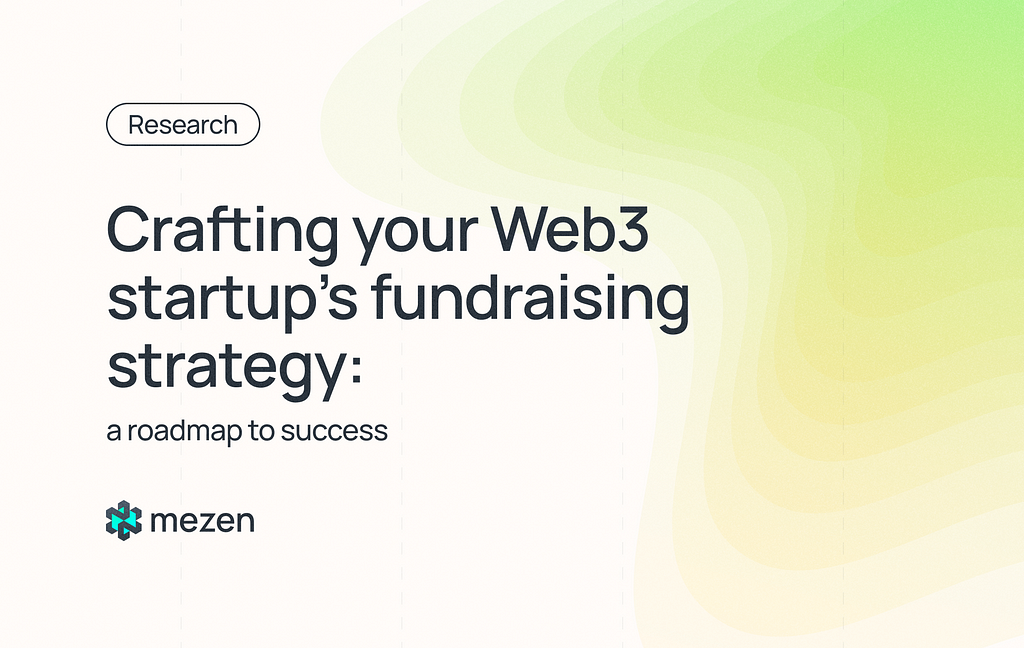If You Shout Loudly About Token Unlocks, the Buyer Definitely Won’t Come
 Introduction
IntroductionIn the fast-paced world of Web3, having a well-planned fundraising strategy is not only helpful but also crucial. As blockchain technology and decentralized systems continue to disrupt industries, companies in this field face unique obstacles and opportunities when it comes to raising funds.
A wise fundraising strategy does more than just fill your company’s coffers; it lays the groundwork for your project’s future, influencing everything from development timeframe to market positioning. The amount of capital you seek, as well as who provides it, can have a big impact on your startup’s trajectory, team composition, and even the basic essence of your product or service.
Furthermore, the Web3 landscape provides a varied range of funding opportunities that do not exist in traditional marketplaces. From crypto-native venture capital firms to decentralized autonomous organizations (DAOs) to public investment rounds, the possibilities are as innovative as the technology itself. However, the number of options makes it even more important to approach fundraising with a defined strategy.
In this article, we will walk you through the process of creating a fundraising strategy specifically for your Web3 project. We’ll look at how to establish your financing requirements, navigate the numerous funding sources accessible, and match your fundraising efforts with your overall project objectives. Whether you’re creating the next major DeFi protocol or using blockchain to revolutionize supply chain management, grasping the subtleties of Web3 funding is the first step toward making your vision a reality.
Determine your funding needsBefore you contact investors or organize token sales, you should have a clear grasp of how much cash your Web3 project requires. This is more than just picking a number that sounds good; it’s about serious consideration and strategic preparation.
Assessing your project’s financial needsBegin by outlining your project’s roadmap for the following 12–18 months. Consider all prospective expenses, including listing and market-making.
Take these factors into account when determining how much to raise:
- Runway: Aim for a minimum of 12–18 months’ operational capital. This allows you adequate time to complete major goals and prepare for the next funding round, if necessary.
- Market circumstances: In a bull market, you may raise more to take advantage of favorable conditions. In bad markets, focus on raising the essentials.
- Competition: Look into how many similar initiatives have been raised and how they are progressing. This might help you set standards for your personal fundraising objectives.
- Upcoming financing rounds: Consider how this round will prepare you for future rises.
- Impact of funding amount on company value and dilution: the amount you raise has a direct impact on your company’s valuation and the equity you will have to give up.
Raising too much too soon might lead to overvaluation, creating excessive expectations for subsequent offerings. Raising too little may compel you to dilute more in subsequent rounds if you have not met important milestones. Consider the choice between preserving greater control (by raising less) and having more resources to accelerate expansion (by raising more).
Remember that in the Web3 world, traditional equity isn’t the main factor. If you’re developing a token-based model, consider how your fundraising strategy may impact token economics and distribution. Finally, the appropriate amount to raise must strike a balance between having enough resources to achieve your objectives and running a lean, efficient business capable of adapting to the quick changes in the Web3 landscape. Take the time to study the facts, speak with consultants, and match your financial requirements to your overall project goal.
Types of funding sources in Web3Entrepreneurs in the Web3 field have access to a wide variety of funding options, each with its own set of benefits and drawbacks. Let’s look at three key categories:
Angel investorsHigh-net-worth individuals who spend their own money in early-stage businesses.
Advantages
- Offer more than simply finance, including mentorship and network connections.
- Can make quicker judgments than institutional investors.
- May have specialized knowledge in Web3 technology.
Considerations
- Investment sizes are smaller than in VC firms.
- There may be less defined systems for due diligence and support.
Professional investors that pool limited partners’ funds to invest in high-growth potential startups.
Advantages
- Can provide greater sums of capital.
- Often provide strategic support, industry connections, and operational knowledge.
- Add credibility to your initiative, potentially drawing more investors.
Considerations
- More strict due diligence procedures.
- May necessitate more formal governance and reporting mechanisms.
- Could impact the company’s direction and decision-making.
Initial DEX Offerings
Token sales are conducted through decentralized exchanges.
Advantages
- Immediate liquidity for tokens.
- Available to a broader group of investors.
Considerations
- Regulatory uncertainties in certain jurisdictions.
- Potential for price fluctuation immediately after sale.
Getting your token sold directly to investors using the smart contract on your site.
Advantages
- An active marketing effort increases your valuation.
- Potential for market validation.
Considerations
- Pre-selling tokens require a unique smart contract
- Can be pricey, particularly for high-end marketing campaigns.
A strategy of issuing tokens for taking part in a liquidity pool that tries to decrease initial volatility and deter large players from dominating the market.
Advantages
- Can lead to more equitable token distribution.
- Facilitates price discovery without undue speculating.
Considerations
- Increased complexity compared to typical token sales.
- May require more education for your community to understand the process
Each of these funding sources has advantages and disadvantages, as do many others that are being considered. The best option is determined by a number of factors, including the stage of your project, financial requirements, and long-term goals. It’s also worth mentioning that many successful Web3 projects use a mix of these sources at various phases of development.
When selecting financing sources, evaluate not just the capital they supply but also how they align with your project’s ethos, the value-add they contribute in addition to money, and how they fit into your overall tokenomics and governance strategies.
Crafting your pitchIn the competitive Web3 landscape, a great pitch might mean the difference between receiving funding and being passed over. Your pitch should not only explain your project but also generate enthusiasm for its possibilities.
We have already done a nice piece on crafting your pitch deck. You can check it here: https://medium.com/coinmonks/effective-pitch-strategies-for-startups-54e781b2fd62
Furthermore, you should be prepared to address common investor concerns.
Scalability
- Address how your solution deals with scalability challenges.
- Discuss plans to handle increased user load.
Adoption challenges
- Acknowledge the hurdles in user adoption for Web3 technologies.
- Provide your strategy for resolving these problems.
Sustainability of the token model
- Explain how your token model generates long-term value.
- Address concerns regarding speculation vs utility.
A clear timetable with well-defined milestones is critical for both project development and fundraising efforts. This roadmap not only directs your team but also gives potential investors a clear picture of your project’s future.
Setting realistic fundraising goals and deadlinesAssess your runway
- Estimate the duration of your current finances, taking into account market volatility and unforeseen expenses.
Research market conditions
- Understand the current investor state of mind in the Web3 space.
- Adjust your timetable to take advantage of favorable market conditions.
Allow enough time for investor talks, due diligence and other time-consuming parts
- Prepare for the process to take longer than intended.
- Create a buffer time for unanticipated delays.
Securing finance is an important milestone, but it is only the beginning of your journey. Long-term success in the Web3 market requires effective investor relations management and balancing growth with expectations.
Remember that in the Web3 world, your investors are frequently also early adopters and community members. Nurturing these ties extends beyond standard investor relations to creating a devoted, active community that believes in your project’s goal.
Investor relations in the Web3 space require:
Regular communication
- Create a regular updating schedule (e.g., monthly newsletters, quarterly reports).
- Use both traditional ways and Web3-native venues (such as token-gated Discord channels) for updates.
Transparency
- Be open about challenges and triumphs.
- Provide clear and accurate information on project development and token metrics.
Community engagement
- Encourage investors to participate in community discussions.
- Consider establishing special channels for larger investors or advisory board members.
Governance participation
- If applicable, explain how investors can participate in decentralized governance.
- Educate investors about the significance of their involvement in a decentralized ecosystem.
Regulatory compliance
- Keep investors updated on regulatory developments affecting your project.
- Demonstrate continuous commitment to compliance and legal best practices.
Token price versus project development
- Help investors concentrate on fundamental project development rather than short-term token price fluctuations.
- Provide context on how project milestones may effect token value in the long term.
We began by highlighting the significance of precisely estimating your financial requirements, taking into consideration not only immediate development costs but also the runway required to reach major milestones. We then looked into the many funding options accessible in the Web3 ecosystem, ranging from traditional angel investors and venture capital firms to novel public campaigns such as IDOs and liquidity bootstrapping pools.
Crafting a captivating pitch has emerged as an important phase, requiring you to properly describe your project’s value proposition, address any investor concerns, and demonstrate a thorough understanding of your market and technology. We emphasized the necessity of developing a realistic timeline with specific, attainable goals that are consistent with your financing rounds and overall project vision.
Our conversation concluded with post-funding issues, which highlighted the continuous importance of investor relations and the delicate balance between growth and achieving investor expectations in the fast-paced Web3 environment.
Key takeaways to remember:
- Make your fundraising plan specific to your project’s requirements and goals.
- Take advantage of the unique financial options in the Web3 market while remaining cautious of regulatory constraints.
- Communicate your vision clearly and support it with a solid plan and measurable milestones.
- Create and build good ties with your investors, treating them as collaborators on your project’s journey.
- Maintain adaptability and transparency as you negotiate the changing Web3 world.
Remember that fundraising is more than just securing funds; it is also about finding the ideal partners who share your vision and can contribute to the project’s success. By addressing fundraising strategically and with a long-term view, you may put your Web3 project on track to not only fulfill but surpass its potential.
The Web3 space is still in its early stages, with plenty of opportunities for new applications. With a well-crafted fundraising strategy, a clear goal, and consistent execution, your initiative may collect the resources required to make a long-term impact in this transformative sector.
As you begin your fundraising adventure, keep your curiosity alive, be open to feedback, and never lose sight of Web3 technology’s transformative potential. The future of the decentralized web is being built today, and with the correct financing strategy, your project may play an important role in defining that future.

Crafting your Web3 startup’s fundraising strategy: a roadmap to success was originally published in Coinmonks on Medium, where people are continuing the conversation by highlighting and responding to this story.
